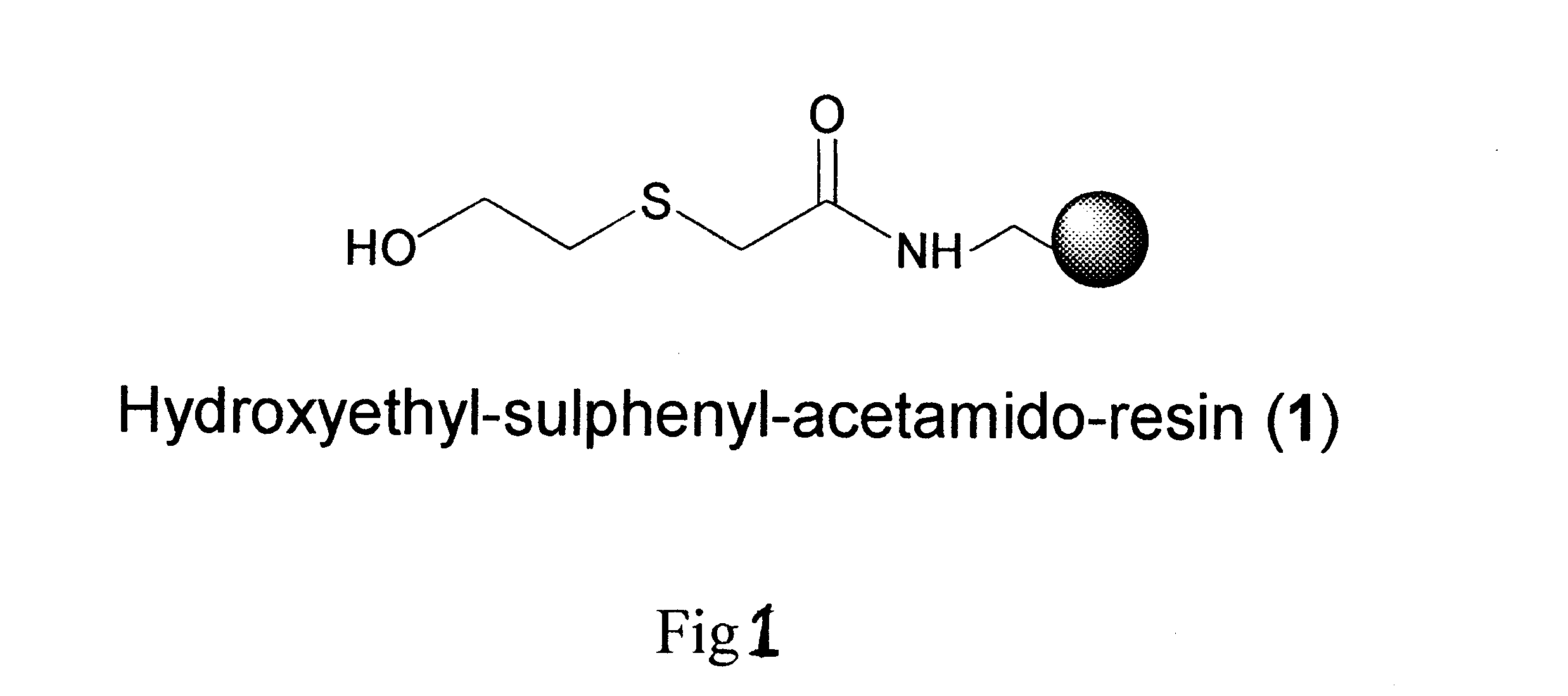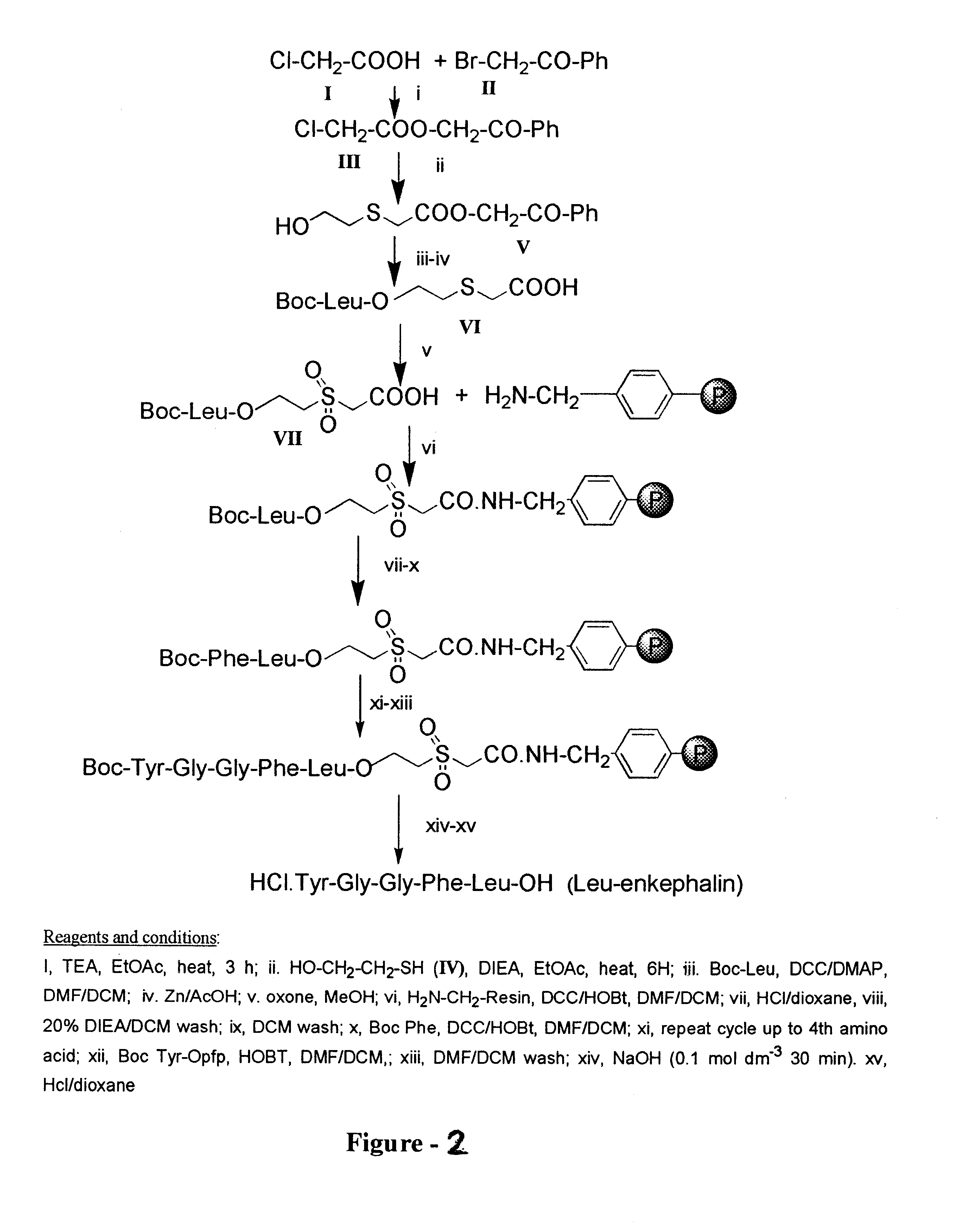Linker based solid support for peptide and small molecule organic synthesis
a technology of organic synthesis and solid support, which is applied in the direction of peptides, organic chemistry, chemistry apparatus and processes, etc., can solve the problems of side reaction and racemization, harm to the molecules, and supports that require relatively mild conditions, and cannot withstand various reagents and experimental conditions used in organic synthesis
- Summary
- Abstract
- Description
- Claims
- Application Information
AI Technical Summary
Benefits of technology
Problems solved by technology
Method used
Image
Examples
example 2
Synthesis of Tyr-Gly-Gly-Phe-Leu-OH (Compound 2)
The solid support, hydroxyethyl-sulphenyl-acetamido-resin (1), (1.25 g, 0.5 mmol) having substitution 0.4 meq / g was placed in reaction vessel and allowed to swell in dichloromethane (DCM) under nitrogen stirring. After 30 min. the resin was filtered and washed with DCM. To this resin a solution of Boc-Leu (0.25 g, 1.2 mmol) dimethylaminopyridine (DMAP) or N-methyl imidazole (NMI) (0.2 mmol) in DCM:DMF (1:1) 20 ml and was added. This mixture was stirred for 8-10 hrs. The resin was washed three times with DCM and dried. An aliquot of this dried resin (2.5 mg) was tested for the loading and the loading was found to be 78% [Method B]. The resin was treated with 50% TFA in DCM for 30 min. to remove Boc group. After 30 min the resin was filtered and washed with DCM 20 ml.times.3, 20% DIEA in DCM 20 ml.times.3, DCM 20 ml.times.3. A solution of Boc-Phe (0.26 g, 1 mmol) and HOBt (0.153 g, 1 mmol) in DCM:DMF (1:1) 20 ml was added to the above re...
example 3
Synthesis of Tyr-D-Ala-Gly-Phe-Leu-OH (Compound 3)
The solid support, hydroxyethyl-sulphenyl-acetamido-resin (1), (0.75 g, 0.3 mmol) having substitution 0.4 meq / g was placed in reaction vessel and allowed to swell in dichloromethane (DCM) under nitrogen stirring. After 30 min. the resin was filtered and washed with DCM. To this resin, a solution of Boc-Leu was attached using 3 molar excess in a usual manner. An aliquot of this resin (3.4 mg) was tested for the loading and the loading was found to be 81% [Method B]. Subsequently, synthesis of Boc-Tyr-D-Ala-Gly-Phe-Leu-OH has been carried out in a manner similar to that applied for getting Boc-Tyr-Gly-Gly-Phe-Leu-OH by substituting Boc-D-Ala instead of Boc-Gly at position 2. After cleavage from the solid support, Boc-Tyr-Gly-Gly-Phe-Leu-OH (0.13 g, 79%) was isolated as white powder. This was then treated with 5N.HCl-dioxan(2 ml) for 1 h in the presence of thioanisole (0.1 ml). After monitoring the reaction by TLC the solvent was evapor...
example 4
Synthesis of Tyr-Gly-Gly-Phe-Leu-OH (Compound 2 through Fmoc-Chemistry)
The hydroyethyl-sulphenyl-acetamido-resin (1) (0.1 g, 0.4 mmol) having substitution 0.4 meq / g was placed in reaction vessel and allowed to swell in dichloromethane (DCM) under nitrogen stirring. After 30 min. the resin was filtered and washed with DCM. To this resin a solution of Fmoc-Leu (0.41 g, 1.2 mmol), DIC (0.2 ml, 1.5 mmol) and dimethylaminopyridine (DMAP) or N-methyl imidazole (NMI) (0.2 mmol) in DCM:DMF (1:1) 20 ml and was added. This mixture was stirred for 8-10 hrs. The resin was washed three times with DCM and dried. An aliquot of this dried resin (2.5 mg) was tested for the loading and the loading was found to be 78% [Method A]. The resin was treated 20% piperidine in DCM:DMF (1:1) 12 ml for 20 min to remove Fmoc group. The resin was washed three times with DCM. After washing the resin with DCM three times, a solution of Fmoc-Phe (0.38 g 1.0 mmol) and HOBt (0.15 g 1.0 mmol) in DCM:DMF (1:1) 10 ml was...
PUM
| Property | Measurement | Unit |
|---|---|---|
| temperature | aaaaa | aaaaa |
| temperature | aaaaa | aaaaa |
| temperatures | aaaaa | aaaaa |
Abstract
Description
Claims
Application Information
 Login to View More
Login to View More - R&D
- Intellectual Property
- Life Sciences
- Materials
- Tech Scout
- Unparalleled Data Quality
- Higher Quality Content
- 60% Fewer Hallucinations
Browse by: Latest US Patents, China's latest patents, Technical Efficacy Thesaurus, Application Domain, Technology Topic, Popular Technical Reports.
© 2025 PatSnap. All rights reserved.Legal|Privacy policy|Modern Slavery Act Transparency Statement|Sitemap|About US| Contact US: help@patsnap.com



